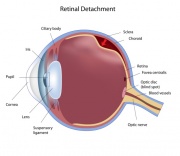Contents |
Central Serous Retinopathy
Introduction
When fluid accumulates in the choroid, the vascular structure located between the retina and the sclera, it may cause the retina to be distorted or raised up from its normal position where it is smoothly lining the inside of the eye. The term serous refers to the fluid, and retinopathy is used to describe any abnormality of the retina.
In central serous retinopathy (CSR) fluid builds up in the area behind the central part of the retina, which then seeps in between the layers and causes them to separate; some of this surplus fluid may also leak into the area of the macula, which we use to get fine details and color vision.
Technically, it may be correct to think of serous retinopathy as a type of retinal detachment, because the retina is pushed away from its normal position where it stays flat against the back of the eye.
Symptoms and Signs
When the fluid accumulates, it may cause any or all of these bothersome symptoms:
- Objects appear to be distorted, miniaturized or magnified
- Decreased clarity of central vision
- Color vision disturbances
- Blind spots
- Metamorphopsia (shape distortion) of objects
- Dim vision
- Poor night vision
Unlike other retinopathies, CSR does not have a specific cause, and in fact, the exact cause is unknown. Many cases seem to be associated with high stress levels, so that people who are widely described as having “type-A” personalities are at higher risk. However, CSR can also occur in pregnancy, so there might be a hormonal cause, which is corroborated by the fact that it can also come as a side effect of medication, especially after high doses of steroids like cortisone. CSR is also occasionally seen after a viral illness accompanied by high fever.
CSR usually affects more males than females between the ages of 20 and 50. Females are seen to have CSR at a lesser rate, and usually between 40 and 50 years of age. Duration of CSR is variable, but most cases resolve without treatment within three to four months. It usually effects one eye only, and be present only very rarely in both eyes at the same time. Recurrence is common, too, and there may be residual symptoms like decreased contrast sensitivity, poor night vision and visual distortions.
Treatment
If symptoms persist longer than three to four months, or if CSR recurs often, there is one effective treatment called laser photocoagulation. The laser is used to seal off leaking blood vessels and repair any tears in the retinal tissue. While this does not cure CSR, it does seem to shorten the active phase of the condition and slightly lowers the recurrence rate of an episode.
Conclusions
Central Serous Retinopathy is one of those mystifying conditions that seem to defy our abilities to find either cause or cure.
The best advice is to see an eyecare practitioner right away if any of the listed symptoms above occur and follow his or her advice. It may require patience to wait it out, or, the eyecare practitioner may advise laser photocoagulation, although this can be difficult in a condition that is still developing new leakages.


